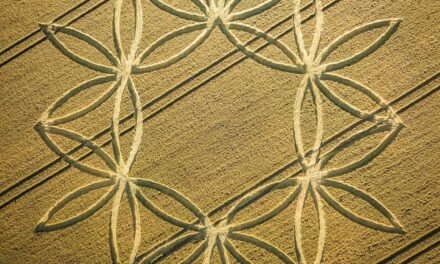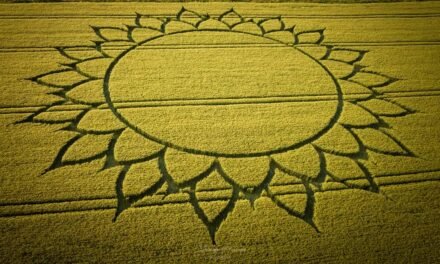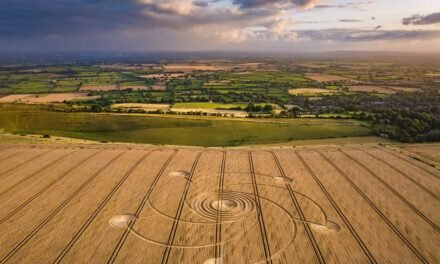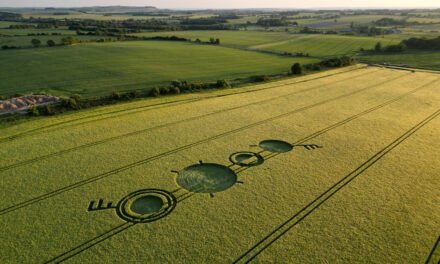
Were the Pictograms of 2023 Telling Us Something?

The Croppie doesn’t usually link to commentary articles on other crop circle websites, but we recently read a very considered piece on the wonderful Circular State of Mind website. Titled ‘Crop Circles 2023: End of the Season’, it’s a brief contemplation on the current state of play in the fields and we’d like to add our own thoughts on the matters it raises.
We’ve reproduced the original article in graphical form below, although we suggest you’d be best served reading it in full at Circular State of Mind by clicking here.

There are three major points for discussion raised in the piece:
- The 2023 season featured strong echoes of the past. We have seen the return of pictograms; throwbacks to 1990 and 1991, one of which was a replica of the legendary East Field formation of 1990. ‘All art looks to the past to some degree,’ writes the author, ‘Art Will Eat Itself. All artists look to the past at some point. The past is their inspiration. All artists steal.’
- Regardless of where you think the circles come from; regardless of whether you think the circles are progressing, stagnating or headed back to a simpler time, you cannot have any expectations of them. What will be will be.
- A crop circle will always reflect the mind of its creator, no matter who or what they may be.
The Croppie agrees that 2023 was a curious year. Those echoes of the past came through strongly. Even the season opener at Broad Hinton was eerily familiar to a formation from the previous decade at Allington. Maybe we are reading too much into it, but the Broad Hinton circle was, at least in terms of spokes, just half of its apparent sibling. This aside, it was the two pictograms at Winterbourne Bassett and Rushock that gave us the most thought-provoking and evocative pieces. At times, it seemed as if the past was, deliberately or otherwise, making its presence known. ‘I believe that ghosts are part of the future’, said the late French-Algerian philosopher Jacques Derrida in the 1983 film Ghost Dance. He was right, although this has been true in the crop circle world for a long time now. Let us explain.

Winterbourne Bassett, 2023. Photograph by Nick Bull
From The Croppie’s perspective, crop circles reached their pinnacle with the Crab Wood event in 2002. No matter whether you think that formation was man made or from elsewhere; no matter if you appreciated its aesthetic or saw it as an abomination, that is all irrelevant. There are two reasons why. One, no other formation since that mid-August day has provided us with such a striking, easily recognisable visual motif. Two, no other formation since then has given us such a thought provoking, debatable and open message as was encoded in the grey alien’s binary disk.
Sure, we have witnessed other beautiful, inspirational and mysterious crop circles in the last twenty one years, but all have fallen short in one or both categories. The 2010 ‘Turin Shroud’ circles at Wickham Green were probably the closest competitors in terms of their deeper meaning, but ultimately provoked fewer questions. The 2009 ‘Owl’ located close to Alton Priors was as visually striking as Crab Wood’s Hollywood style grey alien, albeit less realist in its appearance. But what did it ask us? Very little.
Since Crab Wood, most of the crop circle styles have, with time, disappeared. Love them or hate them, fractals and representations of animals have been and are, for the time being at least, gone. They have joined the thought bubbles, squiggles, insectograms and star maps that had vanished in previous years.
At present, geometric patterns remain the omnipresent force they have been since the back end of the 1990s. It is as if this is the style that keeps giving and little else is left. The first eleven years of the current century were the grand era of the mega-doily and its fingerprints are still to be found across the fields, albeit on a smaller scale, both in terms of size and sheer numbers.
Of course, croppies are complaining. ‘The crop circles have become fewer and farther between. There isn’t the variety. We aren’t seeing messages encoded in the circles anymore. They aren’t as complicated and complex as we used to see.’ The expectations of these people have not been met and so they are frustrated. To be more blunt in certain cases, their sense of entitlement has not been fulfilled.
With this in mind, crop circle enthusiasts should be piecing together a rather small jigsaw puzzle. There is a very obvious answer why circle numbers show a downwards trend, overall, since 2010; a clear solution as to why one particular design style is dominant; a straightforward explanation why crop circles are smaller than they used to be. It is the same answer in each case, but many people either can’t see it or won’t entertain it. Consider what someone who shall remain anonymous said to The Croppie in 2023, ‘I read all of these people moaning that crop circles aren’t what they used to be, but nobody does anything about it. If everything is the shit-show they’re saying it is, they’re getting what they deserve.’
It seems the crop circle making force just does not have the capacity to produce what it once did. New ideas could well be lacking, possibly because nobody (or no thing, if you prefer) with such ingenuity is taking on the task of making crop circles — quite why that may be has been more than hinted at in our series Circle Makers Speak. Or maybe those ideas are there, but the logistical strength to put them into practice isn’t. Only the circle making force knows. We prefer to remain hopeful rather than believe our inability to imagine an alternative future in the English cereal fields has led to an endless reprocessing and repackaging of the same old ideas.
To return to the two pictograms of 2023, at Winterbourne Bassett and Cakebole Lane, Rushock. The arrival of the former was greeted with predictable derision on social media. One Antipodean commentator betrayed his ignorance of crop circle history, suggesting the formation was a bad copy of the East Field circle of 1990, as if that famous piece was a creation that stood alone rather than being one of many in a similar style. It was as if it was scandalous for the humble pictogram to dare make a return to the fields, as if the audience had some say in what was being placed before them, as if this one individual wrongly believed he had some influence; that attempts to humiliate would yield fruit or cause pain. The Cakebole Lane circle, which, ironically, clearly was a full scale replica of the 1990 East Field pictogram, was received more warmly for its nostalgic reminder of times past and was covered in a spread of national newspapers. But, as you would expect, not everyone was so content. Why go back in time? Why make something so basic by modern standards? The Croppie has been mulling it over.

Cakebole Lane, Rushock, 2023. Photograph by Kris Malford
At the close of The Field Guide: The Art, History and Philosophy of Crop Circle Making, Rob Irving suggests the circles may, ‘one day … revert to occasional, relatively small outbreaks in the vicinity of Warminster and the Wiltshire/Hampshire border, echoing a time, not so long ago, when an unassuming man [Doug Bower, who instigated the contemporary phenomenon in the 1970s] saw magic in communion with our mystical landscapes and acted upon it.’ Whilst we haven’t quite seen Irving’s scenario reach fruition, there is still plenty to think about.
- Are the two pictograms of 2023 a reminder of a more innocent period when there really was mystery, magic and wonder to be found in our haunted fields, rather than patterns that are quickly claimed by self-centred, attention-seeking makers?
- Could it be that the pictograms pay homage to a time when the crop circle world was a simpler place, when expectations were limited to circles, rings, dumbbells, forks, ladders and corridors?
- Are the 2023 pictograms thinly veiled warnings that this is what the crop circles have been in the past and what they may so easily become in the near future?
- Or is the circle making force simply communicating it doesn’t care what anyone thinks and will do exactly what it wants to, at a time and in a place of its own choosing?
Maybe we should not limit ourselves to single answers. Perhaps some, possibly all of these explanations posed as questions present worthy solutions. Certainly, as is suggested over at Circular State of Mind, we should not just lower our expectations; we should completely abandon them.





